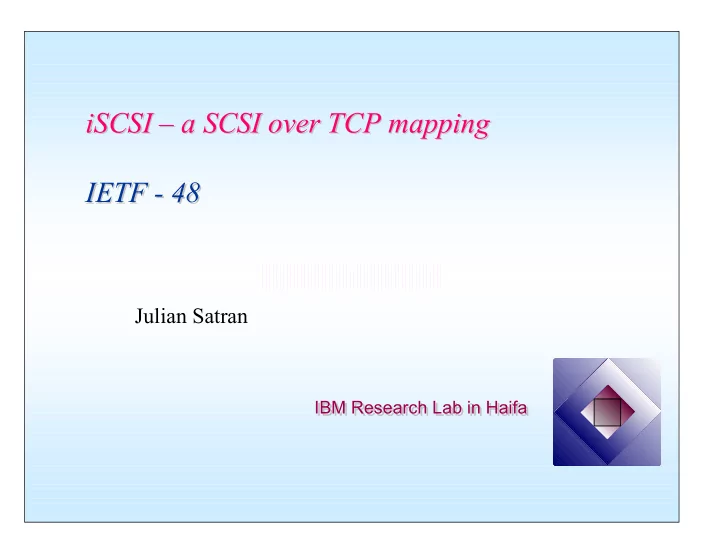

iSCSI – – a SCSI over TCP mapping a SCSI over TCP mapping iSCSI IETF - - 48 48 IETF Julian Satran IBM Research Lab in Haifa IBM Research Lab in Haifa
Objective Objective � Performance � Interconnect will meet or exceed current storage needs and enable growth � High bandwidth, minimum latency � Availability � Enable various levels of recovery � Cost � Reuse whatever available � A good network citizen � Congestion control � Security
Design goals Design goals � Minimalist design � Enable efficient implementations � No or minimal options � Features can be ignored without affecting interoperability – no negotiation or setting beyond that mandated by SCSI for basic functions � Clear layering of functions � SCSI � iSCSI � transport/delivery network
Basic mechanisms Basic mechanisms � Sessions and connections � Login, authentication and security � Commands, messages, tasks and tags � Ordered delivery – the numbering scheme � The response numbering scheme � Recovery � Each of the basic mechanisms has a minimal functionality that must be implemented
Sessions and connections Sessions and connections � A session is a set of TCP connections linking an initiator and a target � It is long lived � It is meant to provide bandwidth and availability � several connections = more bandwidth � Several connections = better availability provided fail over is enabled � The initiator is supposed to be able to use any connection to execute a command and keep all the command related packets on the connection it started the command (connection allegiance) � Minimum requirement – 1 TCP connection/session
Login, authentication and security Login, authentication and security � Login has multiple functions: � session building � authentication and security � some parameter negotiations � Authentication and security � none � authentication only � authentication & encryption – IPsec & TLS � Minimal implementation – session building
Commands, messages, tasks and tags Commands, messages, tasks and tags � Commands & Responses are mappings of SCSI and carry an initiator-wide unique tag � The initiator tag helps relate all the elements of a command (command, optional data and response) � Messages are used to: � manipulate tasks or check/set the whole SCSI/iSCSI path (in which case they carry also a tag) � Check only the iSCSI transport in which case they don’t carry a tag � A compliant implementation must support all command and message types but can choose to ignore parameters as outlined in the draft or reject them
3 stages in the life of a SCSI command 3 stages in the life of a SCSI command � Initiation – delivery from initiator SCSI layer to target SCSI layer � Execution – optional data transfer and RTT � To keep latency at a minimum iSCSI permits unsolicited data transmission as immediate data (attached to the command) or in separate packets � To enable recovery iSCSI mandates honoring target issued RTT � Status transmission from target SCSI to initiator SCSI (status recovery is enabled but not mandated)
Ordered delivery – – the numbering scheme the numbering scheme Ordered delivery � iSCSI enables ordered delivery of commands and tagged messages from initiator to target over several distinct TCP connections � The model used by a target that chooses to implement ordered execution is that of an iSCSI staging-area from which command are delivered to a SCSI device-server only after all preceding commands have been delivered � A sliding window mechanism is used to keep the staging-area within bounds
Ordered delivery – – the numbering scheme the numbering scheme Ordered delivery (cont.) (cont.) � The command numbers are significant only while commands are within the staged area � The only unique identifier for the life of a command is the initiator tag � Ordered delivery is not mandatory – although initiators supporting several connections per session should implement it � Targets supporting several connections per session should indicate the support/lack-of- support for ordered delivery (how?)
The response numbering scheme The response numbering scheme � Responses are also subject to numbering � The main purpose of response numbering is bulk response acknowledgement � Response acknowledgement enables a target to discard whatever residual information it has about a task after the response is acked � Response numbering and acknowledgement is mandatory
Recovery Recovery � Several levels of recovery are enabled by iSCSI: � error notification – broken connections lead to SCSI command failure � command restart – commands pending or in progress on a broken connection can e restarted on a new or one of the remaining connections in a session � data transmission restart – commands can be restarted from a known point in the data transfer (mainly important for long operations)
Recovery (cont.) Recovery (cont.) � Failure to handle data and deadlock avoidance – data can be dropped by targets and reacquired by RTT � The design aim is to enable a session to stay operational as long as a single TCP link can be maintained/established � The mandatory recovery support is error notification and data replay on request (RTT)
Additional mechanisms Additional mechanisms � Text commands � enable parameter negotiations and vendor unique extensions � Mapping � an aliasing mechanism for string mapping into 8 byte “normal” SCSI addresses � to be used for third party naming and access control � Text commands and mapping may be rejected(not implemented)
Not yet polished enough Not yet polished enough � Login / authentication / security � Completely specify including all or elements of new submitted documents (SANRAD) � Register a profile with SLAS? � Text parameters � Rationale/explanations/implementer notes/state diagrams � RDMA/Synch Recovery
Recommend
More recommend